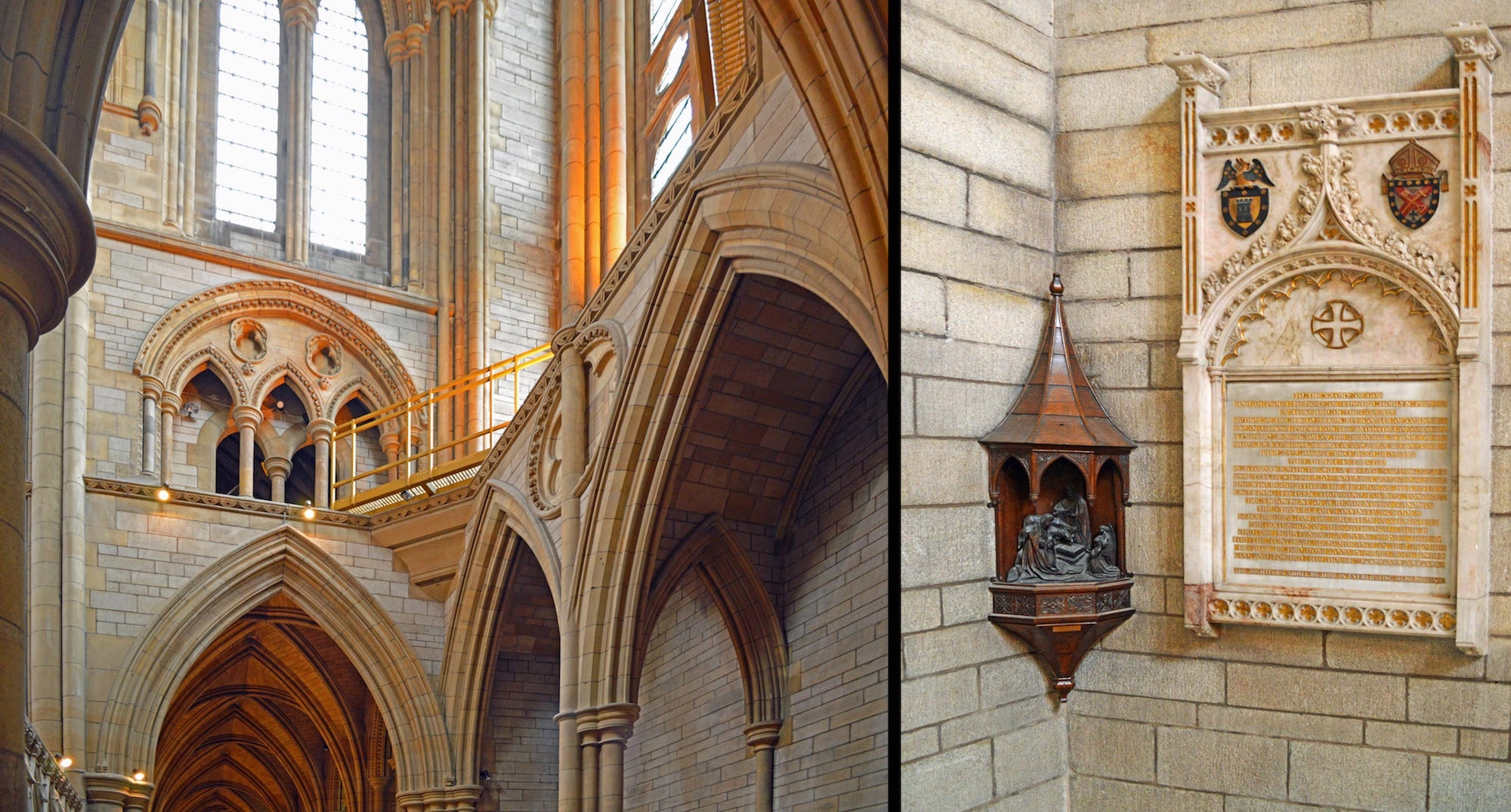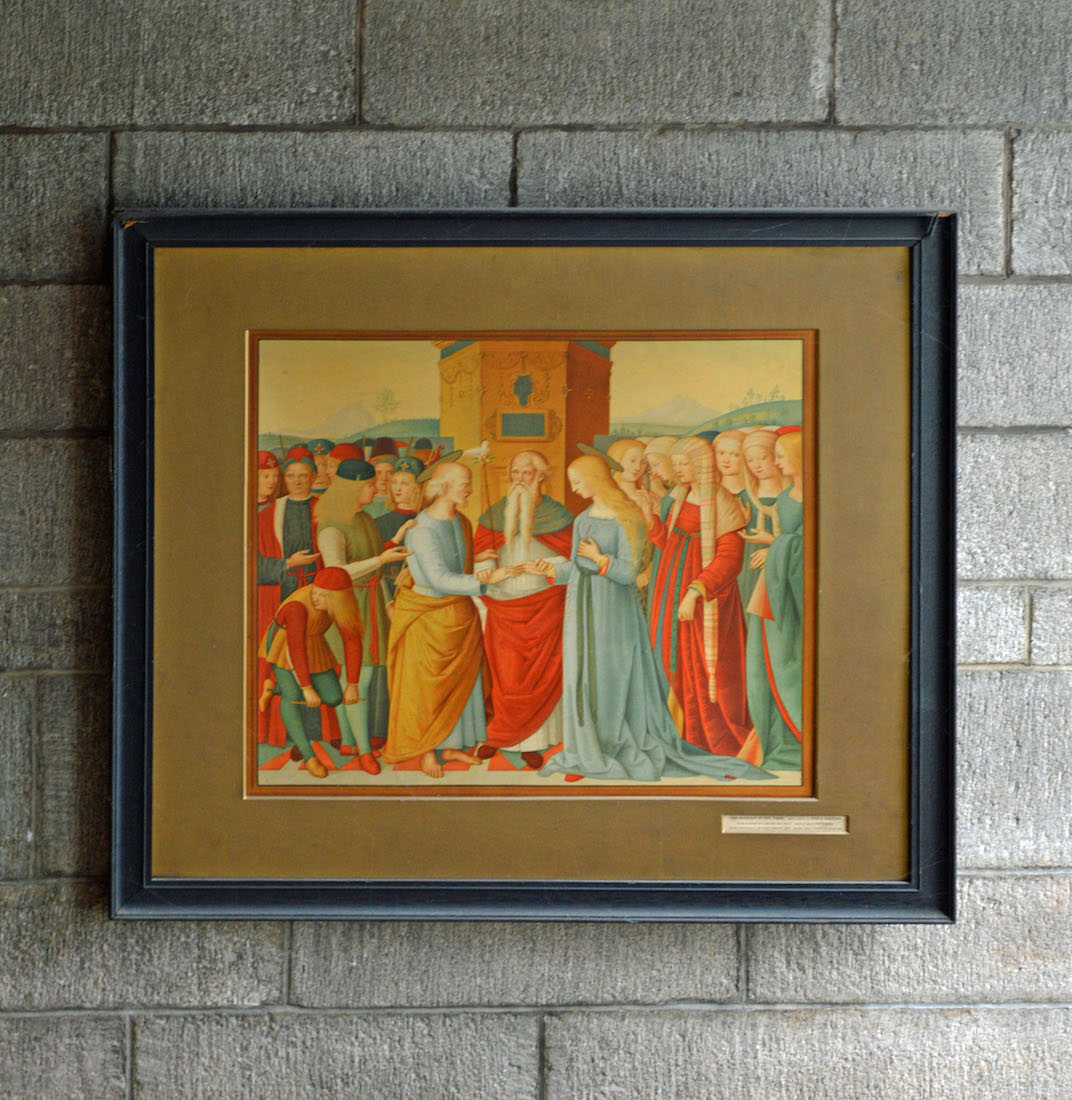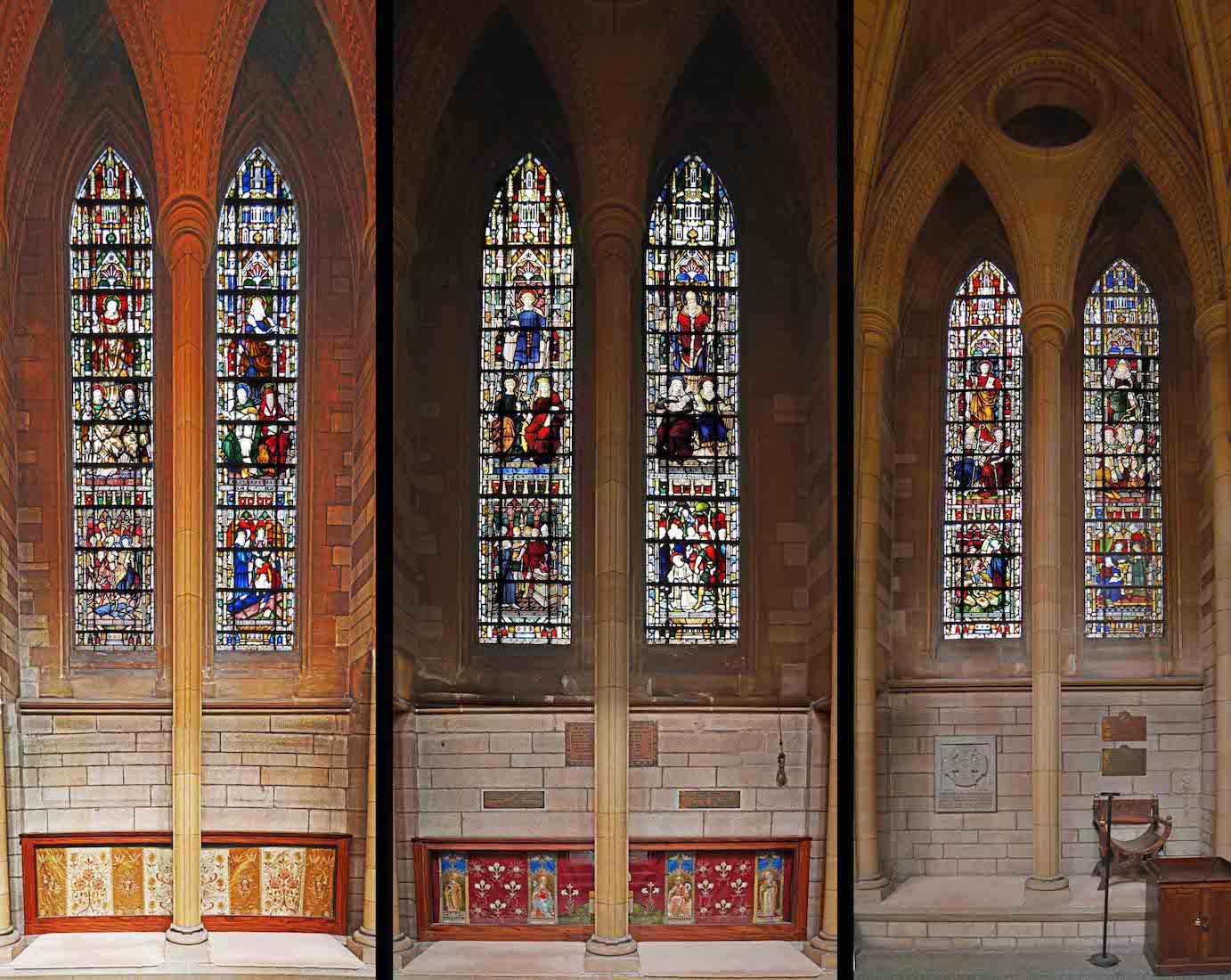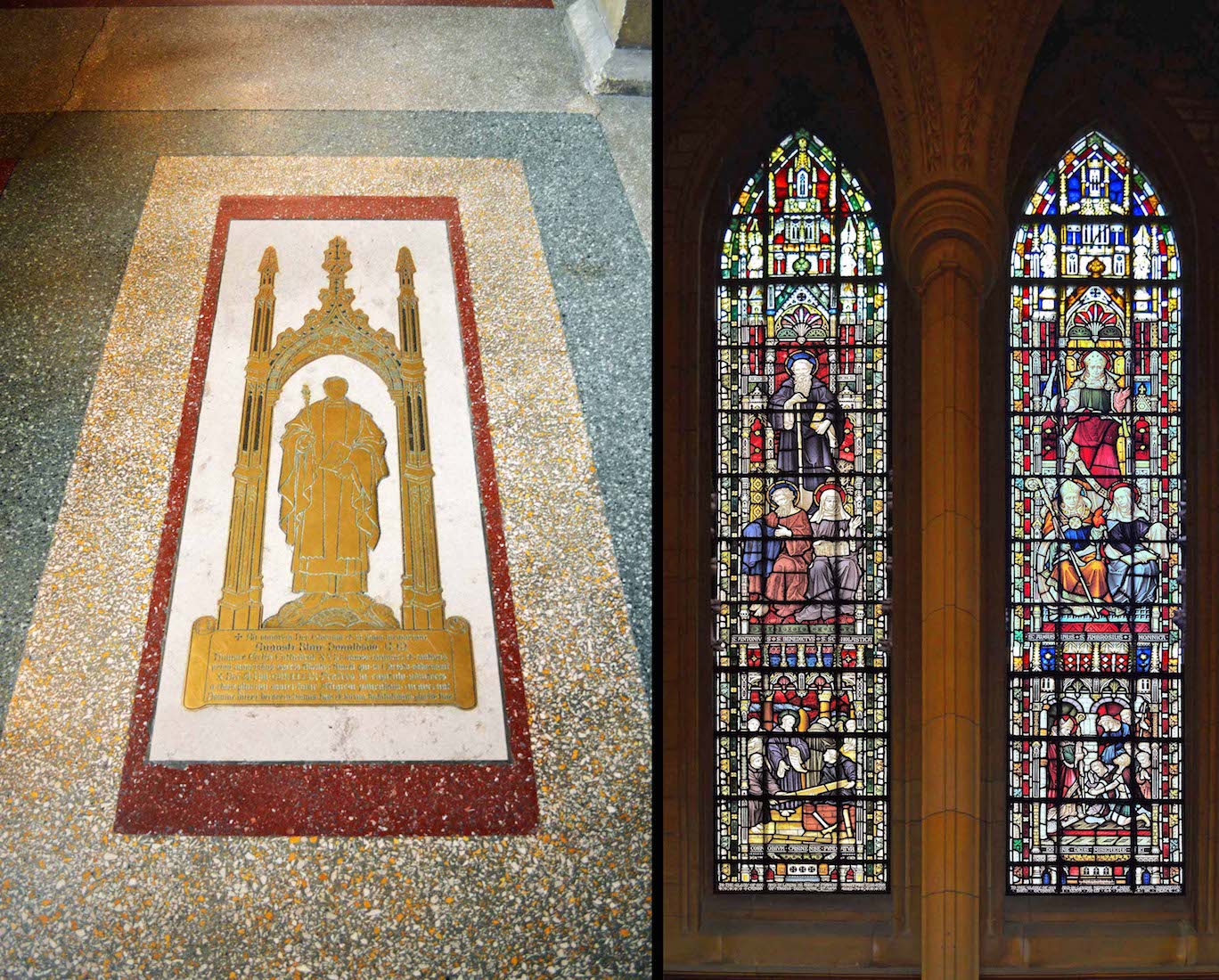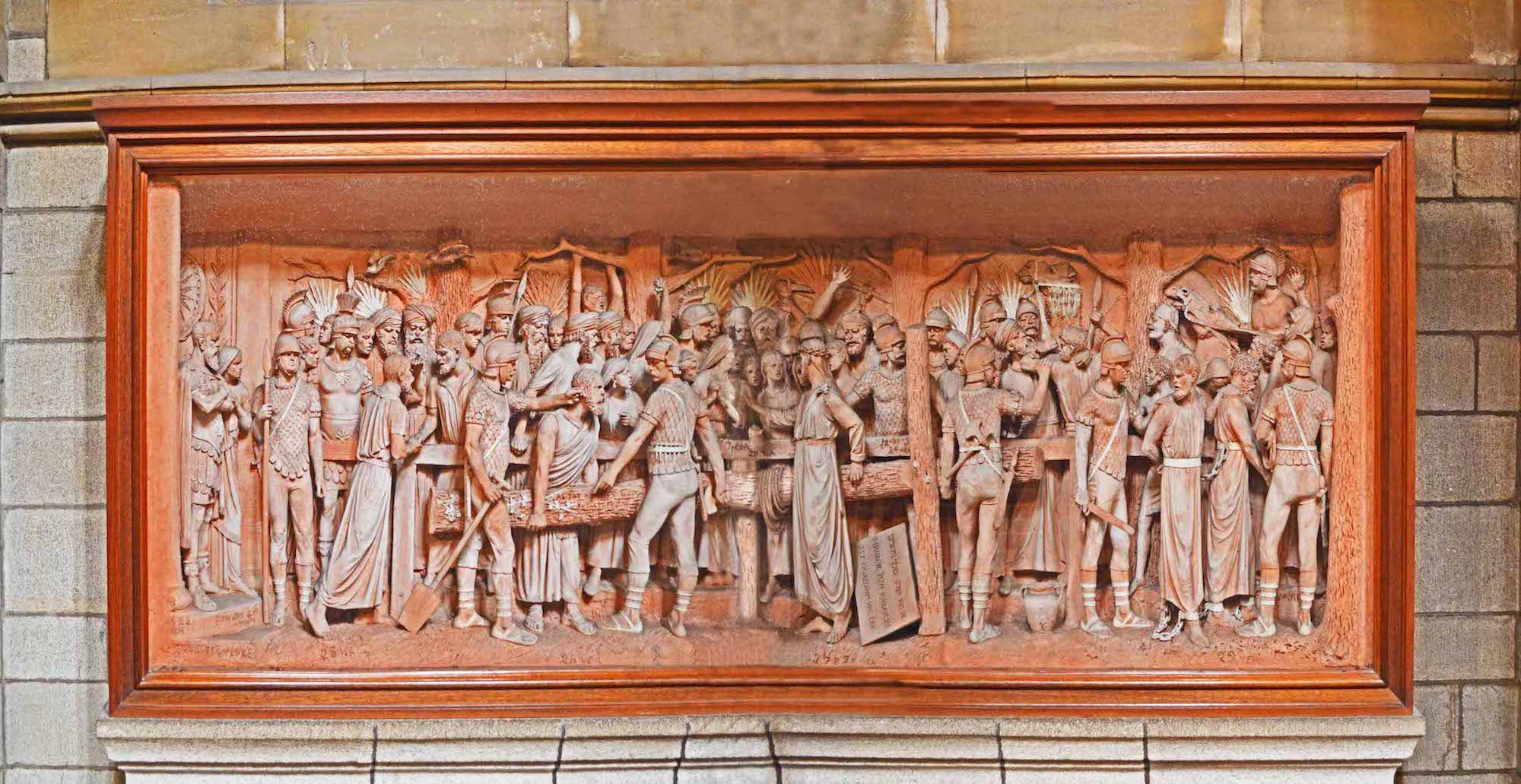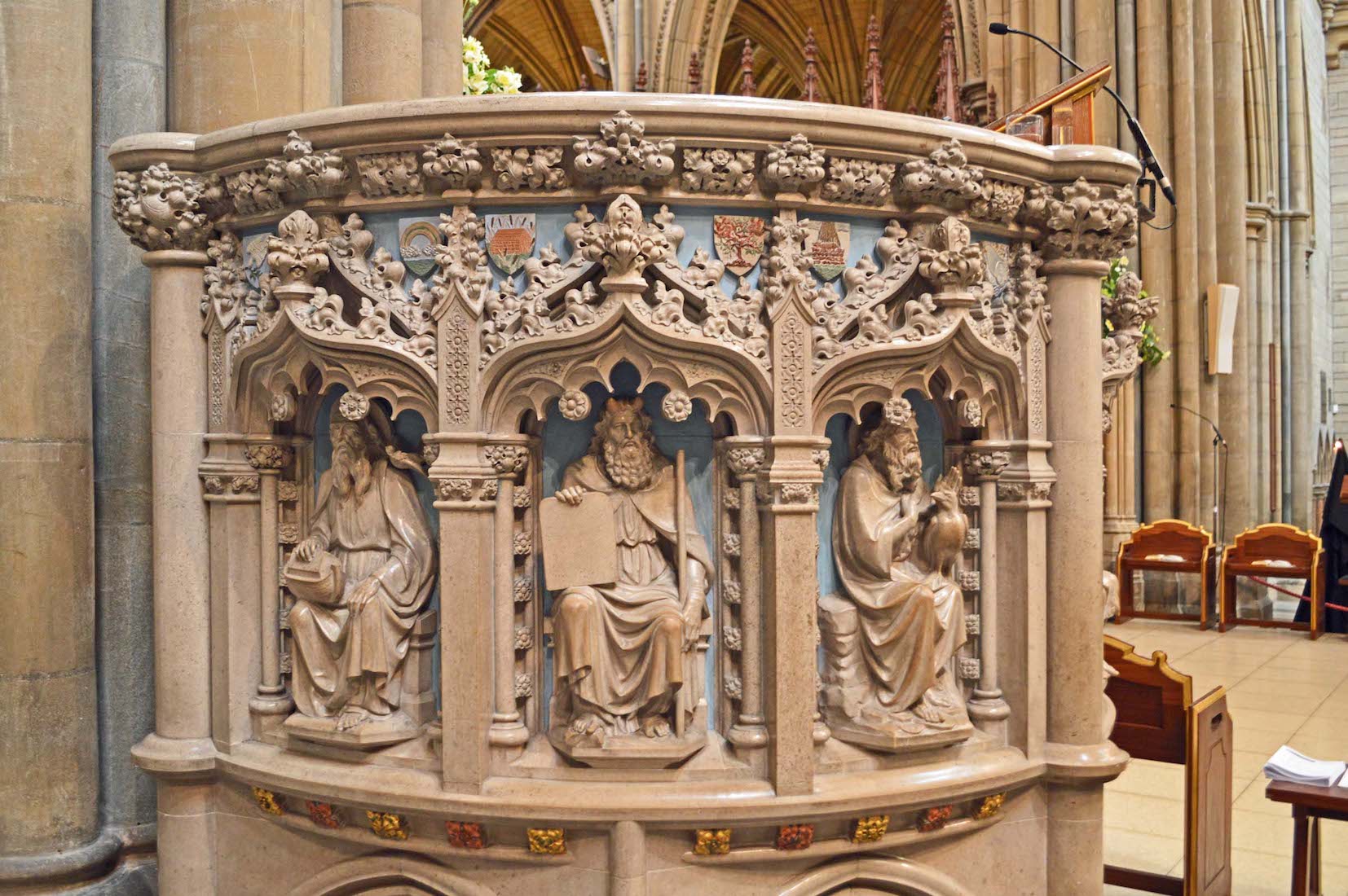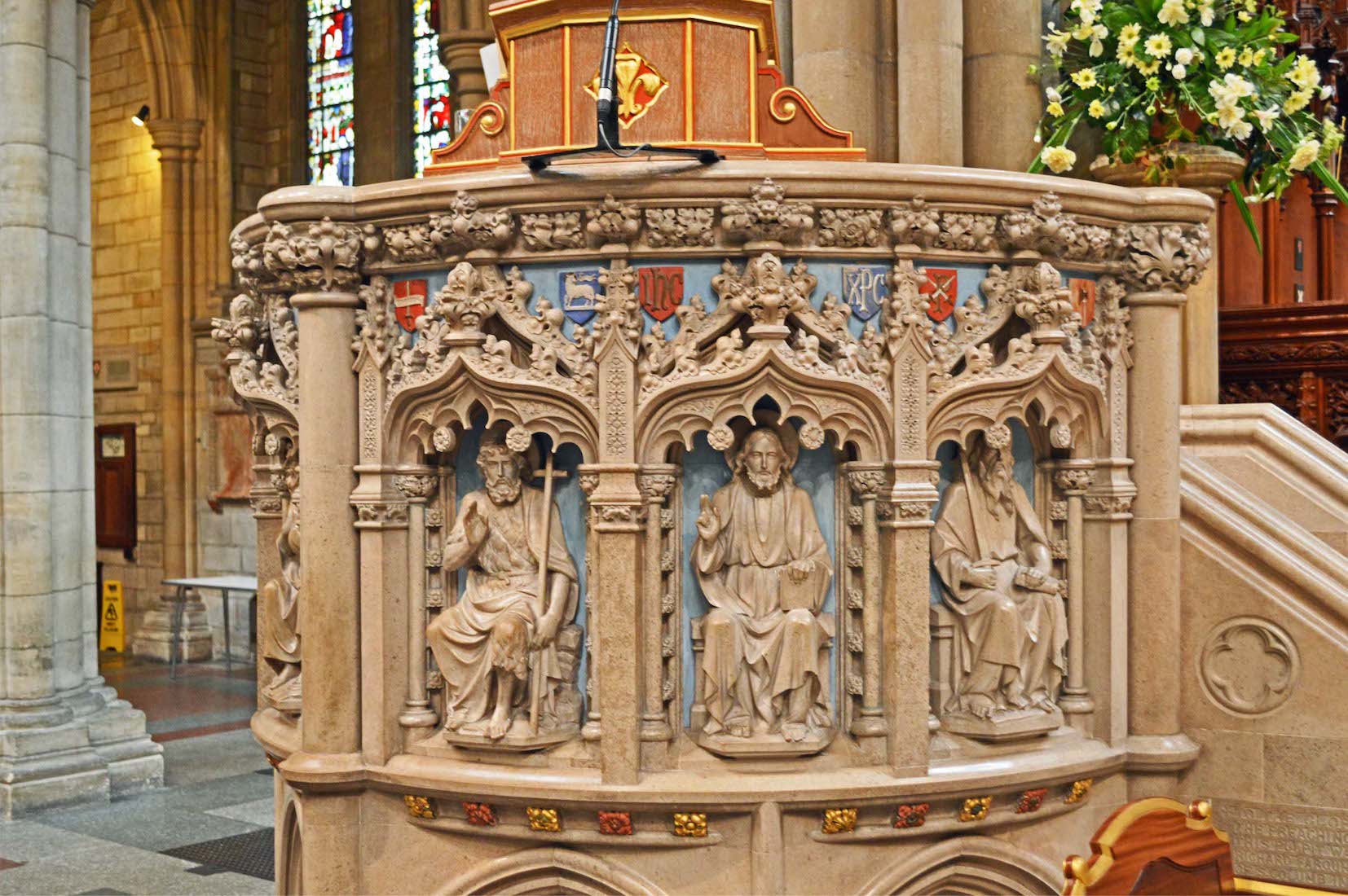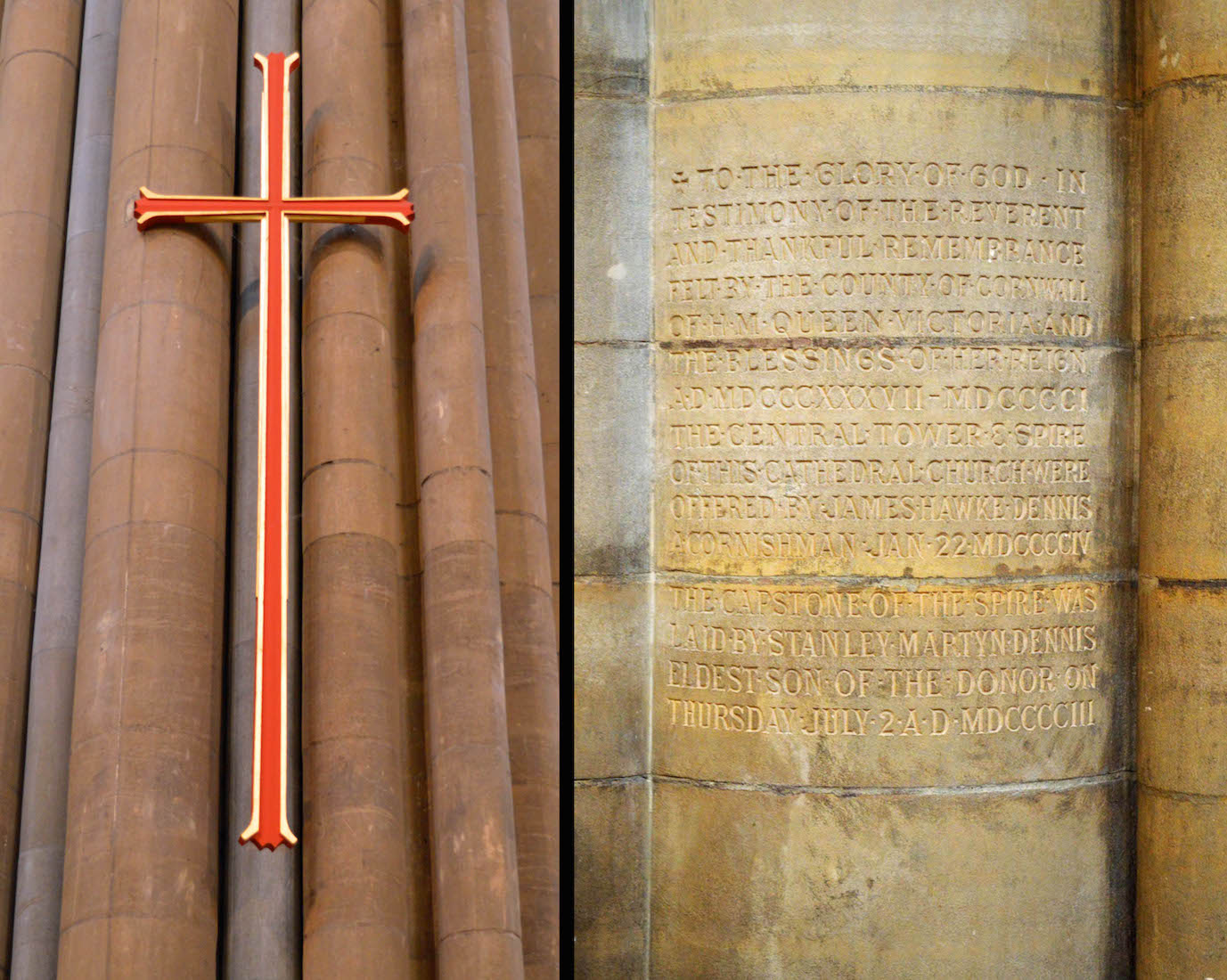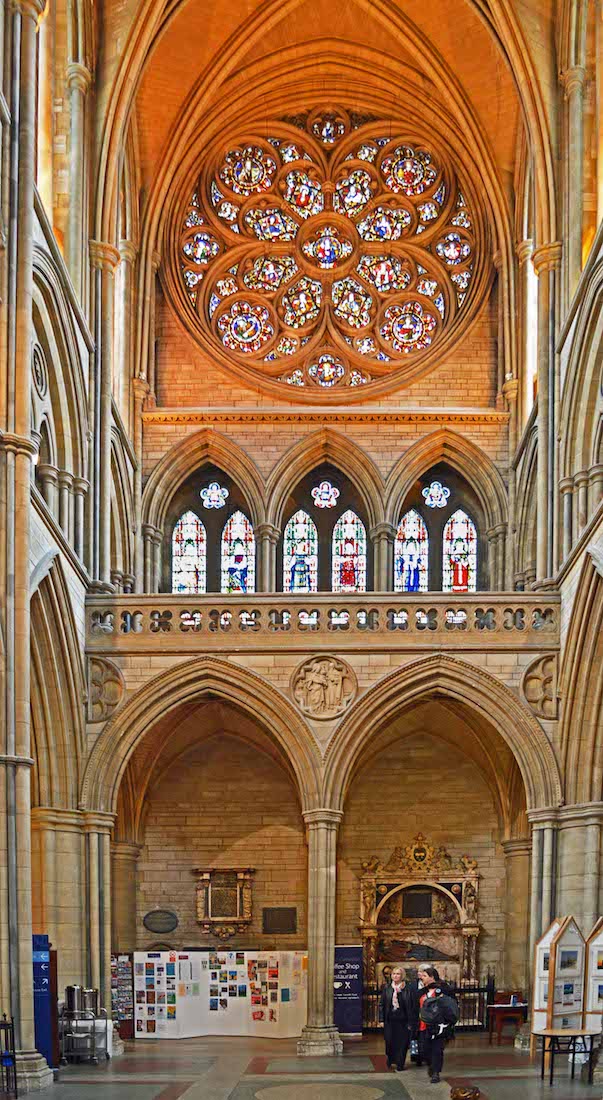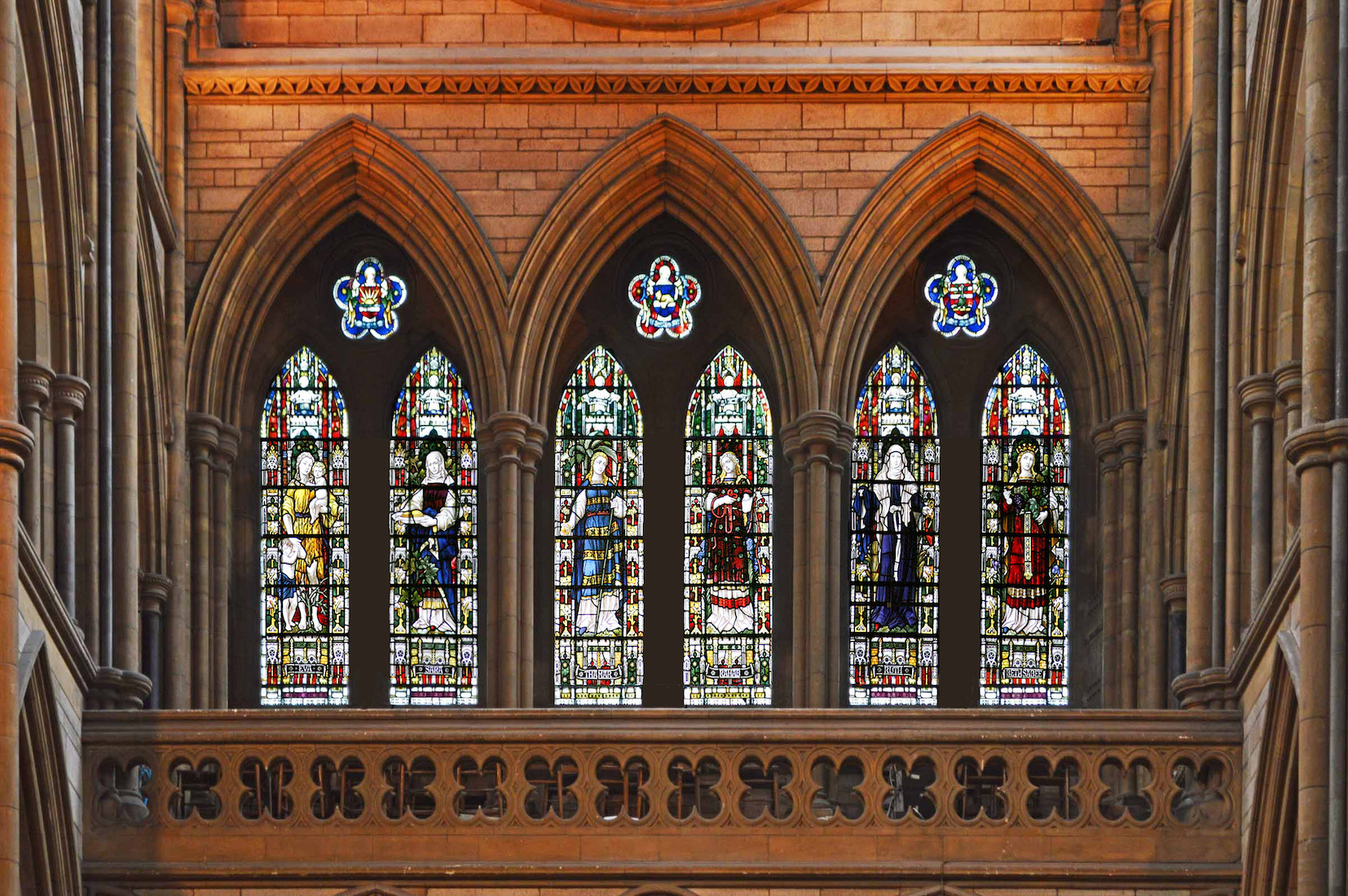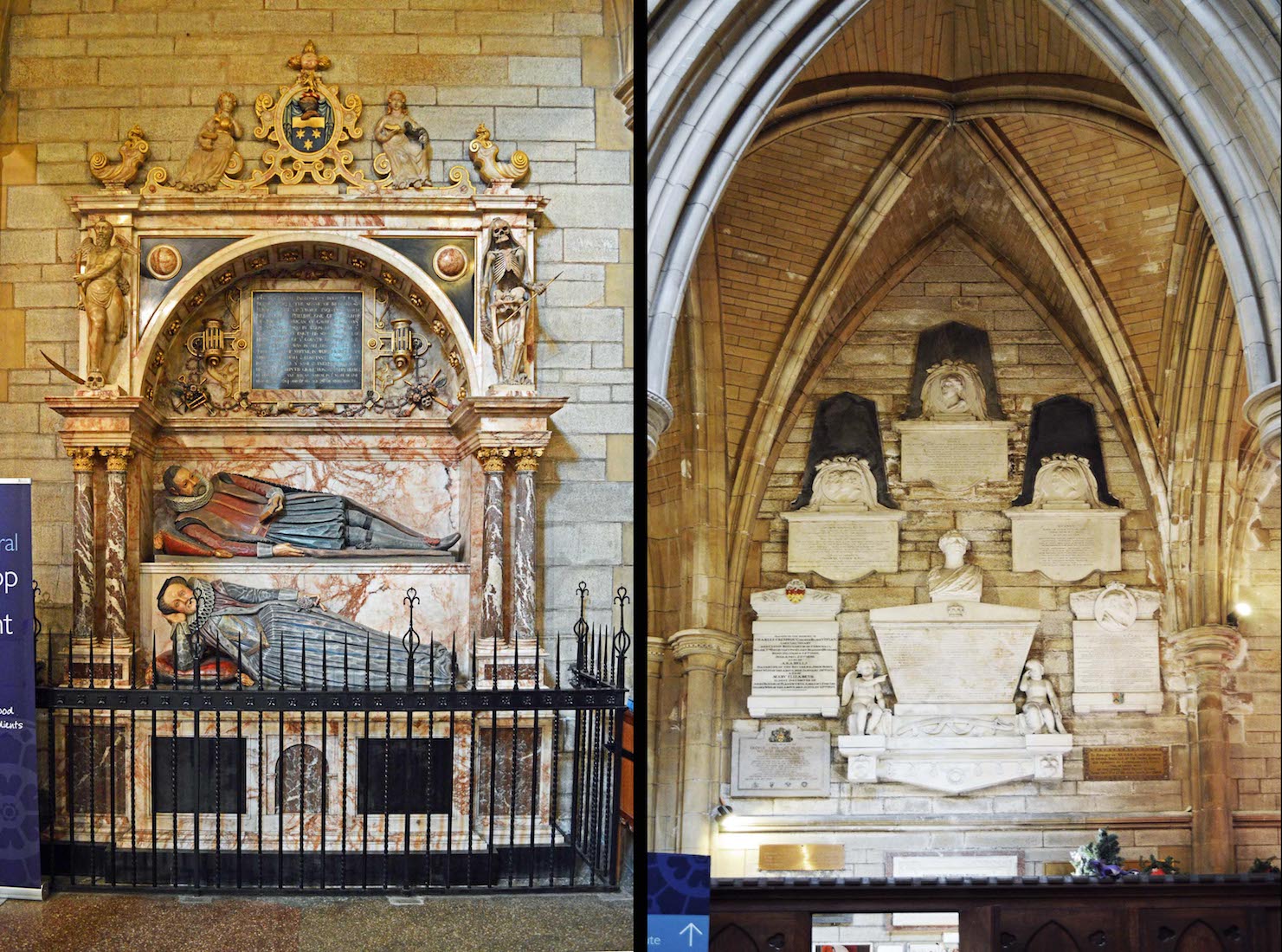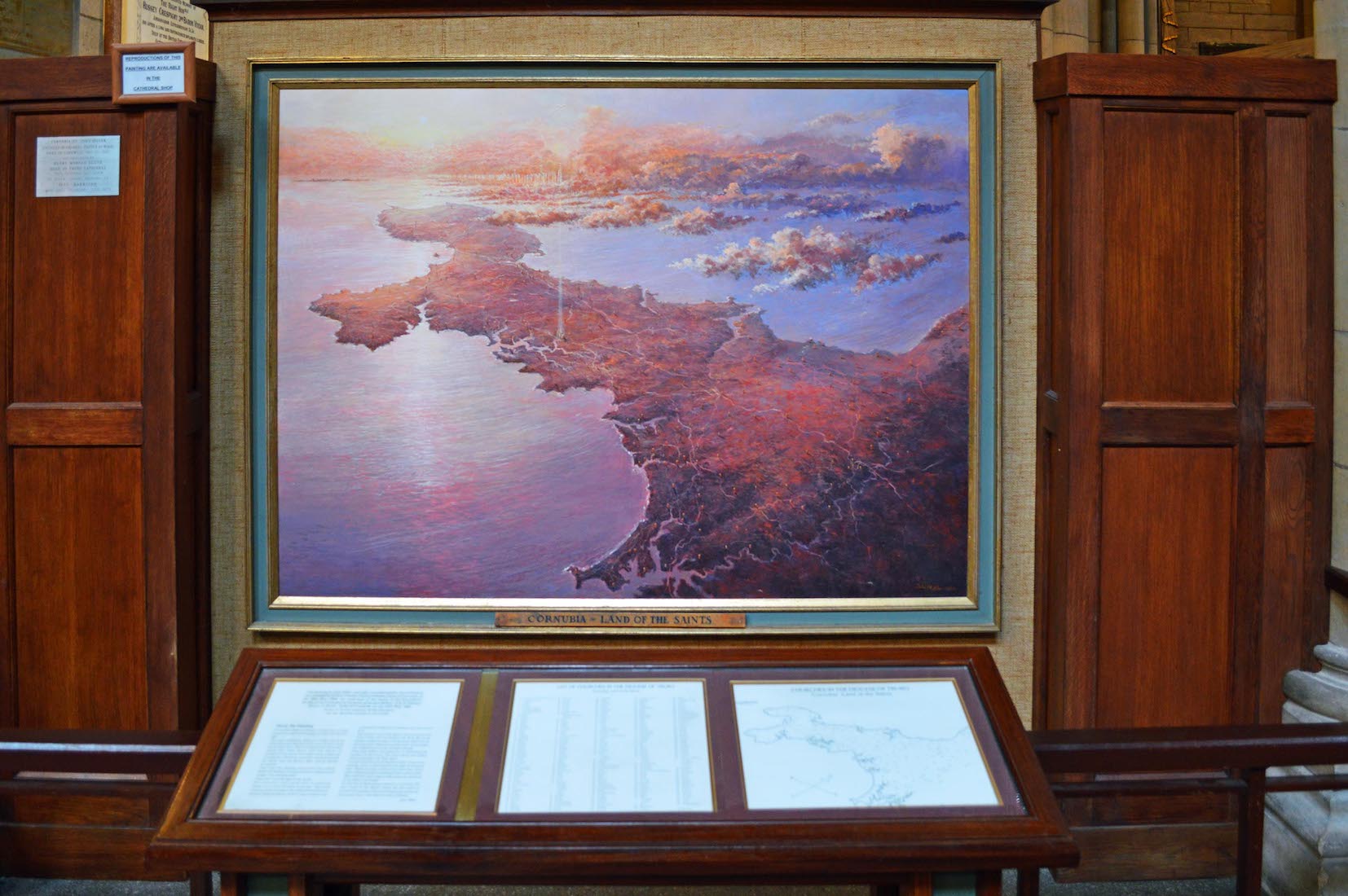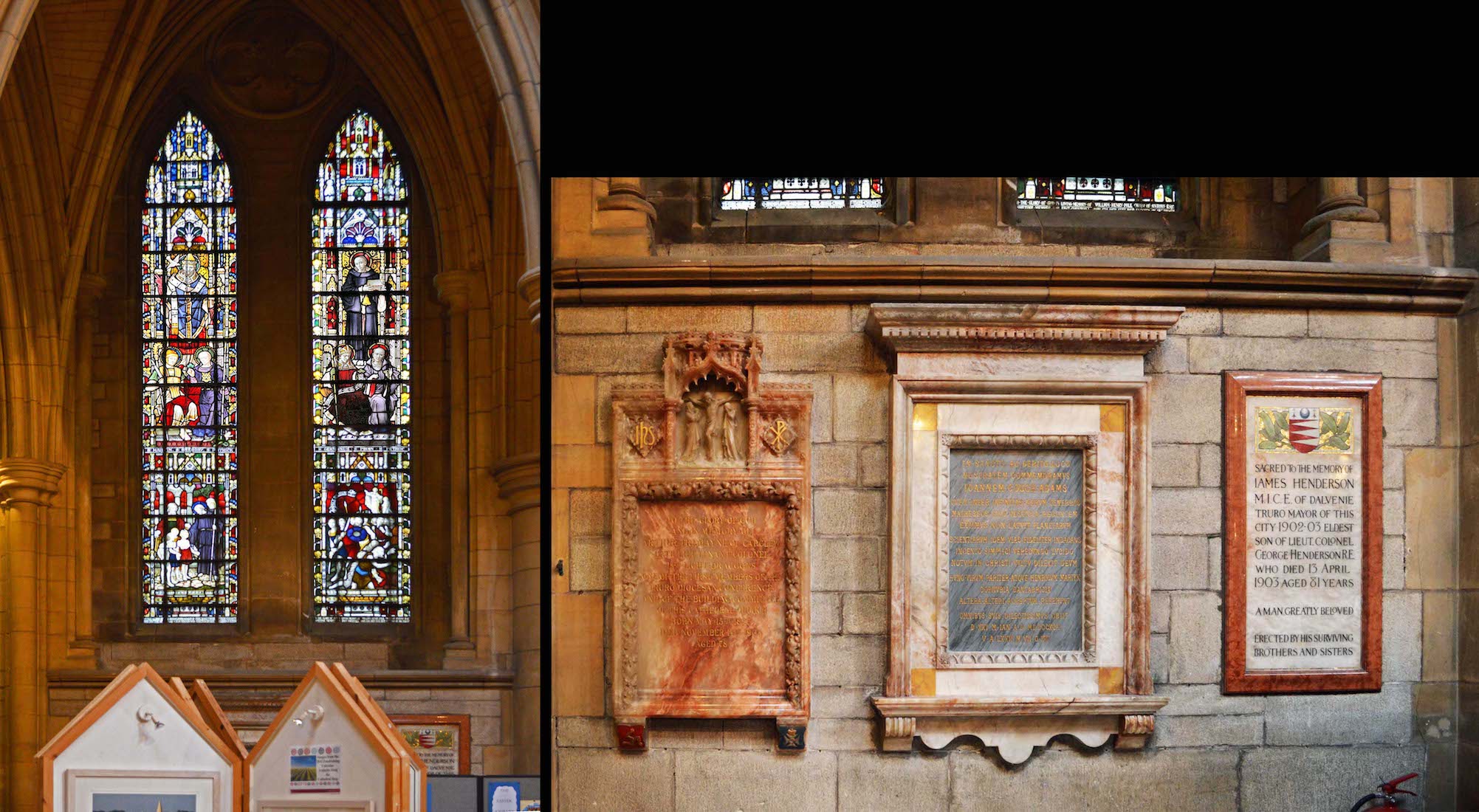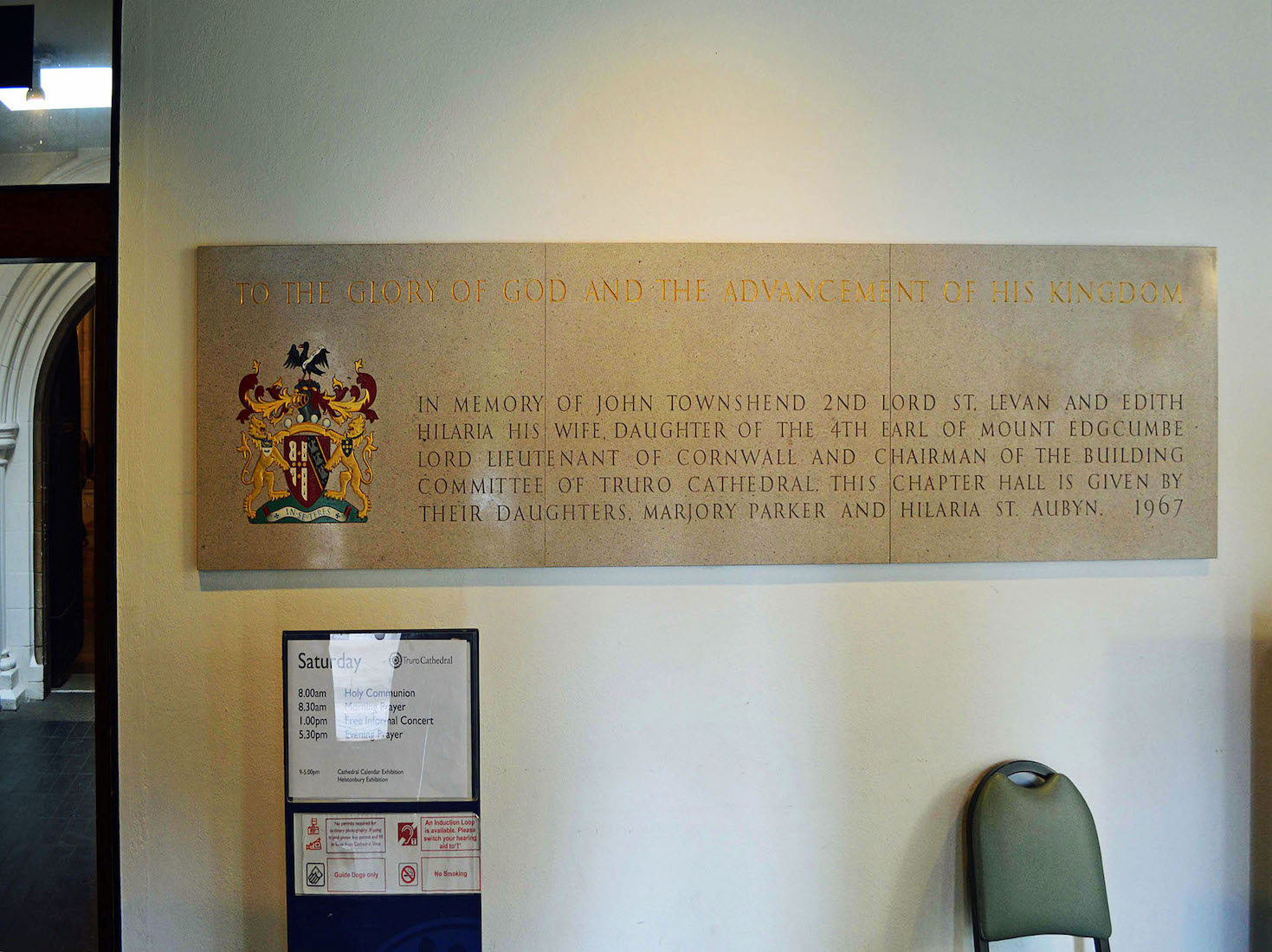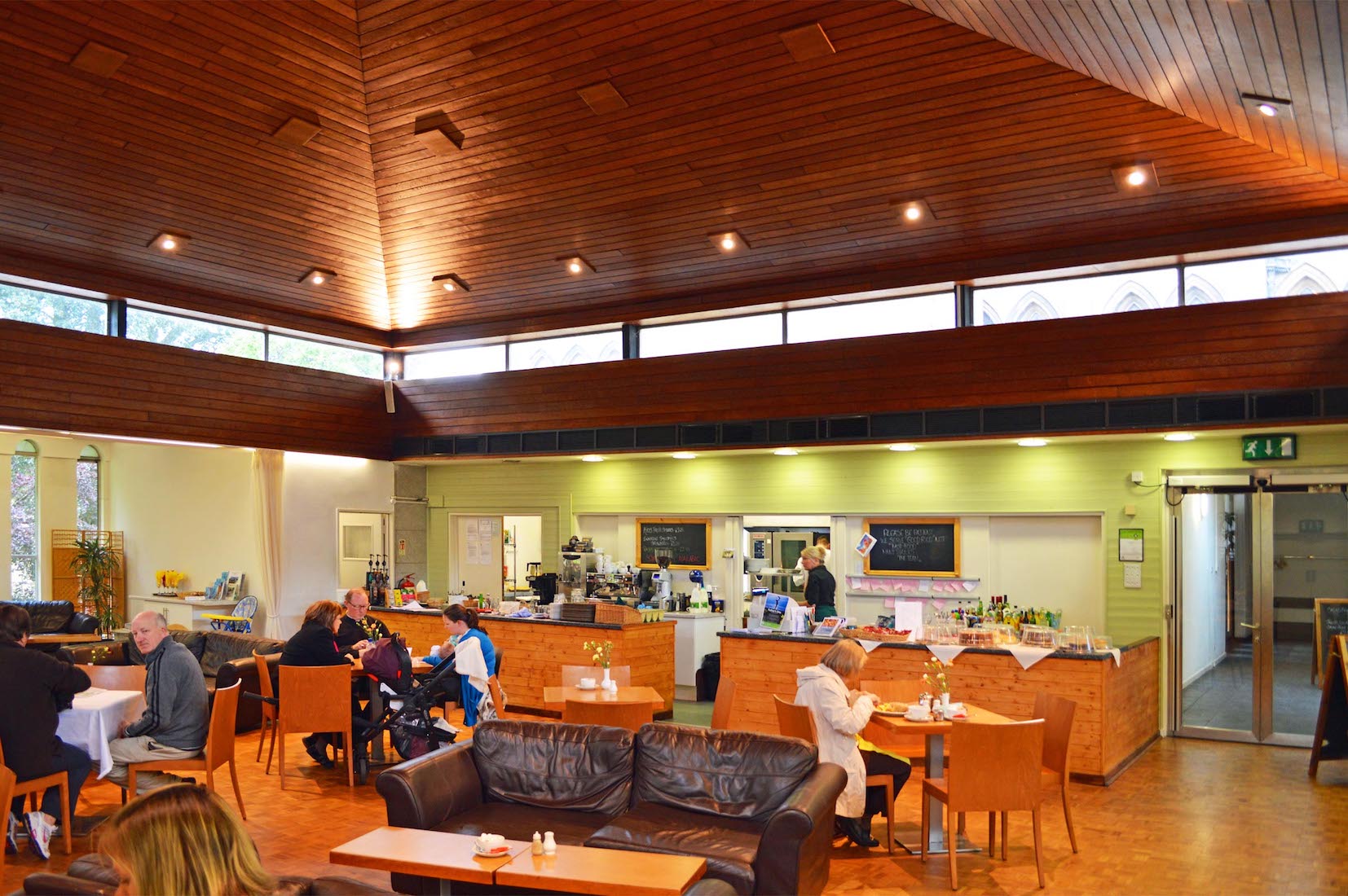61. RETROQUIRE ROOF, WILKINSON MEMORIAL
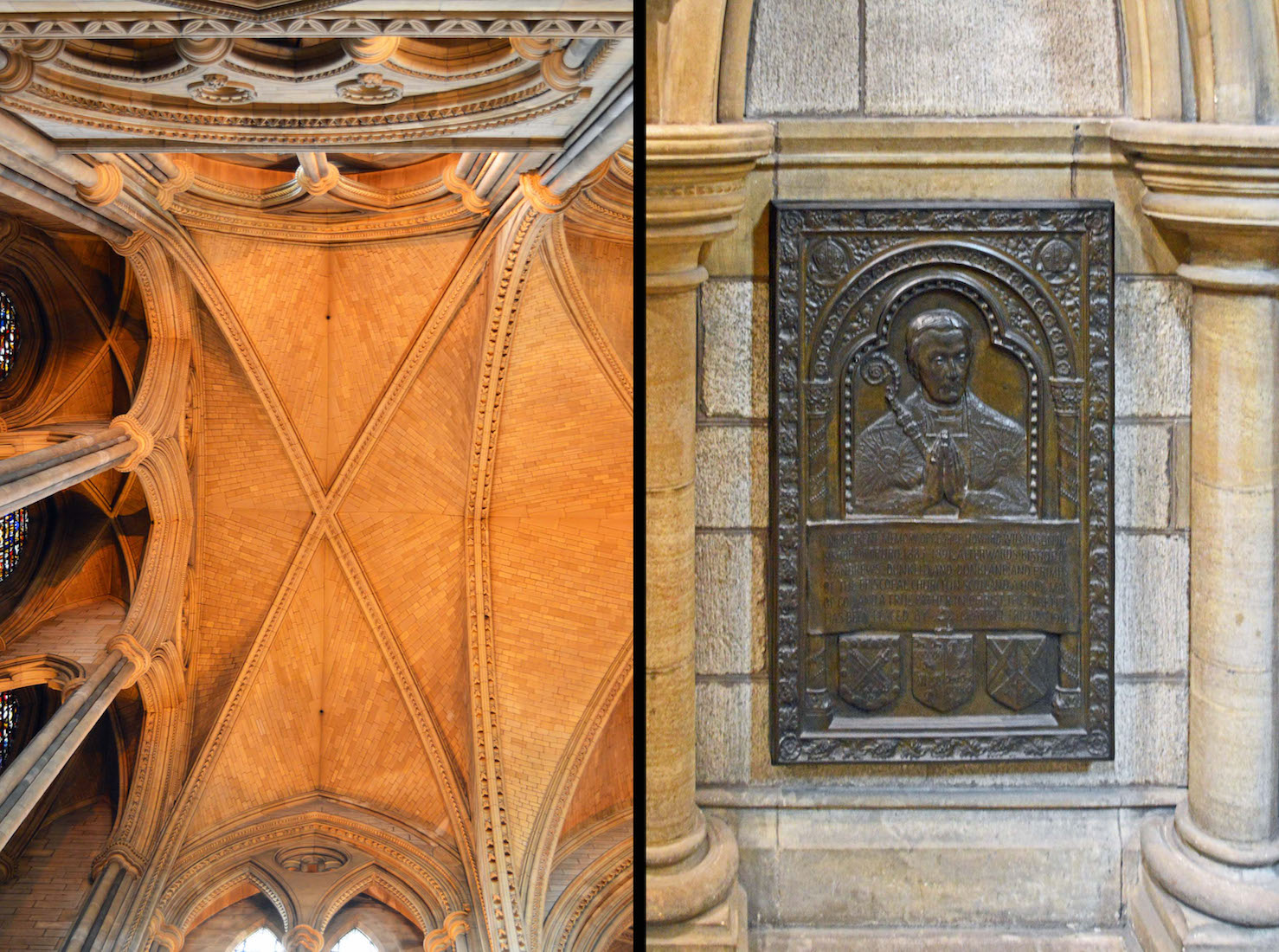
The ceiling of the retroquire conforms to the vaulted brick style of the rest of this Cathedral. • Close by is the brass plaque in memory of George Howard Wilkinson who was Bishop of Truro from 1883 to 1891. PLAN
62. ST MONICA CHAPEL
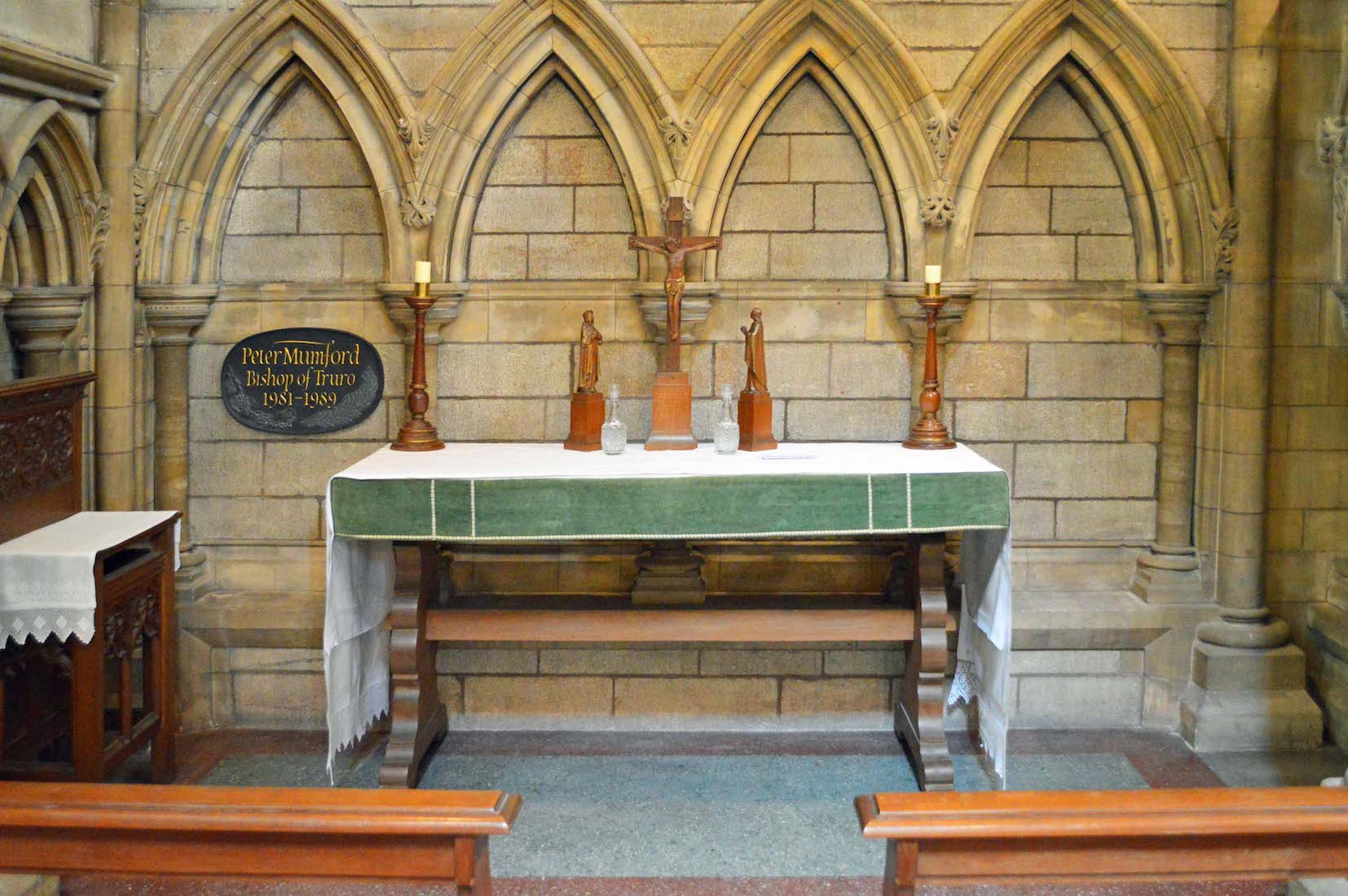
The chapel in the North East corner of the Cathedral is St Monica’s Chapel. Saint Monica (AD 331 – 387), also known as Monica of Hippo, was an early Christian saint and the mother of St. Augustine of Hippo. She is remembered and honoured in most Christian denominations for her outstanding Christian virtues, particularly the suffering caused by her husband's adultery, and her prayerful life dedicated to the reformation of her son, who wrote extensively of her pious acts and life with her in his Confessions.
63. CHAPEL WINDOWS
The windows of the St Monica Chapel are just the reverse of those of the St Margaret Chapel in their placing, with a pair of lancets facing North, and a single lancet to the East. • In the North window, the left lancet shows Dionysius the Areopagate, St Timothy and Onesimus. The scene below has the heading ‘Do the work of an evangelist’. The right lancet shows St Mary Magdalene, St Paul and St Luke. Below is a picture of Saul being confronted by God on the Road to Damascus, with the line ‘This man is my chosen instrument’. • The single (East) window shows scenes of Jesus before the Council, and the imminent stoning of the woman taken in adultery.
64. ARCHES AND WALKWAY, MEMORIAL
The North East transept is a large vertical space with large clear windows and a walkway above the Gothic arches. • In one corner is a quaint little memorial. The tablet is in memory of Edward Hoblyn Pedler of Liskeard, Cornwall, who was the author of the book ‘The Anglo-Saxon episcopate of Cornwall’, published in 1856. The corner decorative niche does have a very small brass plaque: I assume this is related to the tablet.
65. PICTURE
As we turn to walk Westwards along the North Quire aisle, we first come to this framed reproduction of the painting The Marriage of the Virgin. It is from a fresco by Pietro Perugino in the ex-convent of St. Girolamo near Spello, and copied by Signor Fattorini. Why it should be hanging here is not explained!
66. NORTH QUIRE AISLE WINDOWS
These next windows show (from the left): above: St Basil, St Athanaesius, St Chrysostom and below, a couple on a donkey – Alexander and Athena? And the right lancet shows, above: St Origin, St Helena, St Jerome, and below, discovery of the cross. • In this pair of lancets we have from the left, above: St Pancreas, St Alban, St Catherine, and below, St Alban before a judge. In the right lancet we see, above: St Perpetua, St Cyprian, St Laurence, and below, St Cyprian martyred. The first pair of windows continue the past pattern. At left the top panels show St Irenaus, St Pantaenis and St Justin, and below an Island missionary scene. At right we have St Ignatius, St Clement and St Polycarp, and below, St Clement discussing texts with Peter and Paul.
67. BISHOP’S BRASS, WINDOW
The brass in the floor here is for Rev Augustin Blair Donaldson who was born in 1841, and who was Canon Residentiary of the Cathedral. •• The final windows along the North Quire aisle show (from left) • Above: St Anthony, St Benedict, St Scholastic, and below, the founding of the Cassino Monastery • Above St Augustine, St Ambrose, St Monnica (Monica), and below, a man praying with the script ‘Lord have mercy on me’.
68. TERRA COTTA FRIEZE
One of the most admired pieces of sculpture in Truro Cathedral is George Tinworth’s large terra cotta frieze The Way of the Cross. It has great composition and much detail. The composition consists of various passages from the Bible (book, chapter and verse details are actually inscribed in the terra cotta) as Christ carries the Cross to the site of his crucifixion. You might look for Pilate (in the likeness of Edward VII), Barabbas just released from prison shielding his eyes, Simon the Cyrenian helping with the Cross, Christ addressing the daughters of Jerusalem, and others.
69. PASTORAL STAFF, PULPIT
Leaving the North Quire aisle, we now return to the crossing. On the wall here is the Bishop’s pastoral staff. Following the example of Jesus, the Bishop is regarded as the shepherd of his flock, and this is symbolized by a shepherd’s crook or staff. • Nearby is the Cathedral pulpit. This elaborate pulpit was designed by the Cathedral architect, John Loughborough Pearson (1817-1897). It was in place by 1887, when it was described as ‘a noble offering to the Cathedral, by a donor who has enriched the building by his generosity in other ways.’ – Canon Wise, of Ladock.
70. PULPIT DETAIL I
The lower portion of the pulpit is that of an irregular heptagon, supported by a central pier. This pier is emphasized with a column at each angle, extending the whole height of the pulpit, the central one supporting the book-board. At the floor of the pulpit the plan becomes circular. Above the floor are six richly-carved niches, separated by buttresses with pinnacles. In these niches are placed seated figures – here we see Noah, Moses (with horns!), and Elijah. In the spaces above the niches are small shields inscribed with emblems and monograms referring to the figures below. They are the dove with the olive branch and the rainbow, the ark of bulrushes and the burning bush, the altar with sacrifice and fire descending, and the chariot of fire.
71. PULPIT DETAIL II
Moving around the pulpit we come to St. John the Baptist, our Lord, and St. Paul. These figures were all great preachers of righteousness. The surmounting small shields for these figures depict the sword on a pale red background with a label and the words ‘vox clamantis’ (= a voice cries out) and the Agnus Lamb bearing the banner, IHC and XPC, the initial letter P with crossed swords, and the battle-axe on a paler background. This is a very fine pulpit.
72. CROSS, INSCRIPTION
On the column behind the pulpit is a large and striking red and gold cross. The ends of this cross are unusually configured – different from many of the common variants. • Also close to the pulpit is a column inscription relating to the central tower. It reads: To the glory of God In testimony of the reverent and thankful remembrance felt by the County of Cornwall of H. M. Queen Victoria and the blessings of her reign A.D. MDCCCXXXVII – MDCCCCI The central tower and spire of this Cathedral Church were offered by James Hawke Dennis, a Cornishman Jan 22 MDCCCCIV The capstone of the spire was laid by Stanley Martyn Dennis, eldest son of the donor on Thursday July 2 A.D. MDCCCIII.
73. NORTH TRANSEPT
The North transept is something of a utilitarian area: a place for serving tea, a shop, a throughway to the cafeteria, and an access way to the Cathedral. It does have some lovely windows, and a number of wall plaques and monuments that had to be moved from their original locations in St Mary’s Church when the Cathedral was built.
74. NORTH TRANSEPT LOWER WINDOWS
The six North transept windows below the rose window are unfortunately too distant to view in detail. However they depict six women who played an important part in the Old Testament story. From left we see Eve, Sarah, Tamar, Rahab, Ruth and Bathsheba. Eve was the first woman (Genesis 2,3). Sarah was the wife of the patriarch Abraham (Genesis 15 – 21). Tamar is recognized as a woman who fought for her rights (Genesis 38). Rahab was a prostitute living in Jericho who heard and obeyed the will of God. (Joshua 6, 12). Ruth has a Biblical book named after her and was an ancestor of King David. Bathsheba was the mother of King Solomon (2 Samuel 11, 12).
75. MEMORIALS
On the North wall is the impressive 17th century memorial commemorating John and Philippa Robartes. John was a successful local businessman and Mayor of Truro, making the family fortune as a tin merchant. Father Time and Death were frequently used on monuments like this to remind people of their own mortality. • Still in the North transept, we find this grouping of memorials relating to the Vivian family, and dating from 1679.
76. ST GEORGE CHAPEL WINDOW
The West portion of the North transept contains this window featuring St George, and it is from this that the Chapel gets its name. St George is the dominant figure in the group. His portrayal is conventional, clad in armour and helmet. The figure seated to the left represents a bearded St Joseph of Arimathaea wearing Biblical/Roman costume, with the Holy Grail in his right hand. The figure seated to the right represents St Augustine of Canterbury. .
77. NORTH TRANSEPT: CORNISH CHURCHES
Close by the North transept is this painting – Cornubia – the Land of Saints. This was unveiled by Prince Charles, the present Duke of Cornwall, to celebrate the centenary of the laying of the foundation stones in 1880. Painted by well known local artist John Miller, it shows an aerial view of Cornwall with the sun setting in the west. Looking closely, we see the coming of the Celtic saints from Ireland, Wales and Brittany, bringing the light of the Gospel and the Holy Spirit to Cornwall. The Celtic crosses on the painting represent the parish churches of Cornwall, and the Cathedral receives a special shaft of light.
78. NORTH TRANSEPT EAST WINDOWS
These two windows in the East wall of the North transept were visible behind some display screens. The left lancet shows Saints Gregory, Martin and Patrick. The lancet at right shows Saints Piran, Germanus, and Petroc. • Below the windows are these plaques. They remember Arthur Tremayne of Carclew, 1827 – 1900, who served on the Cathedral Building Committee; John Couch Adams, 1819 – 1892, famous Cornish mathematician and astronomer; James Henderson, Lord Mayor of Truro 1902 – 1903,. died 1903.
79. CHAPTER HALL PLAQUE
We leave the North transept and make our way to the Cathedral cafeteria. This plaque tells us that it is in fact a ‘Chapter Hall’ – loosely modelled on the old Chapter House of ancient monasteries..
80. CAFETERIA I
Exploring the Cathedral is tiring work, and we take time to visit the Cathedral restaurant. We have already noted that this was given as a Chapter House to the Cathedral. We found it to be one of the nicest refreshments stops of the cathedrals we visited, with tasty food and friendly service.



